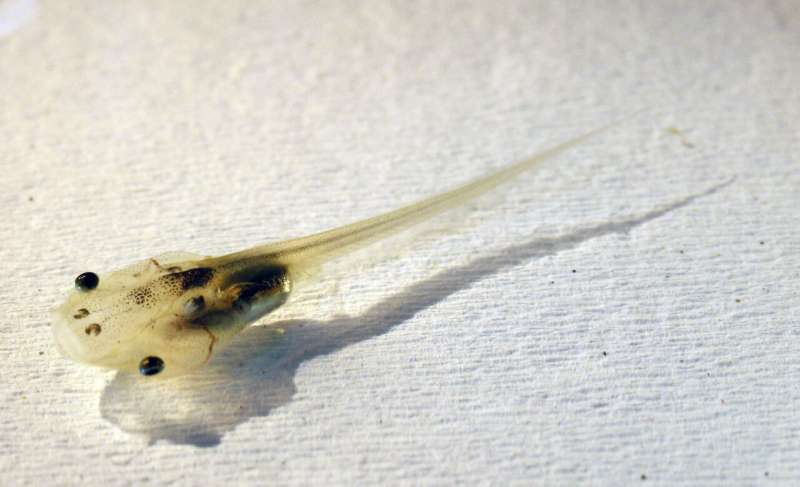Science
Researchers Uncover Key Protein in Tadpole Tail Regeneration

Researchers at the University of Tokyo have identified a critical protein, c1qtnf3, that plays a vital role in the tail regeneration of tadpoles. This discovery may advance understanding of regenerative medicine in mammals. Published on November 17, 2025, in the Proceedings of the National Academy of Sciences, the study sheds light on how muscle stem cells influence immune cells, known as macrophages, to promote tissue regeneration.
The African clawed frog, Xenopus laevis, is renowned for its ability to regenerate fully functional tails. This remarkable process involves the activation of tissue stem cells, essential for regrowth. However, observing these stem cells has proven challenging due to their limited numbers. Taro Fukazawa, one of the researchers, noted, “We have previously established a method for efficiently enriching tissue stem cells. Building on this technique, we aimed to clarify the behavior of these cells during tail regeneration.”
To achieve this, the team employed single-cell RNA sequencing, allowing them to identify actively expressed genes in various cell types. They focused on putative muscle stem cells, discovering that these cells express c1qtnf3 at higher levels than other cell types. To further investigate the role of this protein, they conducted “knockdown” experiments, which involved blocking the function of c1qtnf3.
The results were telling. According to Sumika Kato, another researcher involved in the study, “The knockdown of c1qtnf3 resulted in impaired tail regeneration, indicating that the function of c1qtnf3 is essential for successful tail regeneration.” Additionally, the team observed a decrease in macrophages at the tail stump in the knocked-down tadpoles, suggesting impaired macrophage function.
Linking Stem Cells and Macrophages
The findings led to the hypothesis that macrophages are crucial for regeneration, facilitated by muscle stem cells through c1qtnf3. To gather more evidence, the researchers activated macrophages using another gene, the neutrophil cytosolic factor 1, which is involved in macrophage function. Kato explained, “When I found that forced expression of the gene, and consequently rising macrophage numbers, rescued tail regeneration in tadpoles, it felt like the dots connected.”
This pivotal research proposes that putative muscle stem cells secrete c1qtnf3, leading to an accumulation of macrophages at the tail stump, which promotes effective tail regeneration. The team aims to explore how macrophages enhance regeneration under the influence of c1qtnf3, along with the specific cellular and molecular mechanisms involved in this process.
The implications of this research are significant, potentially paving the way for advancements in regenerative therapies for mammals. Understanding how animals like the tadpole regenerate could inform new strategies in medicine, offering hope for healing damaged tissues and organs.
For more information, refer to the study titled “Putative muscle cells promote Xenopus tail regeneration by modifying macrophage function via c1qtnf3” in the Proceedings of the National Academy of Sciences.
-

 Science1 month ago
Science1 month agoInterstellar Object 3I/ATLAS Emits Unique Metal Alloy, Says Scientist
-

 Science1 month ago
Science1 month agoResearchers Achieve Fastest Genome Sequencing in Under Four Hours
-

 Politics1 month ago
Politics1 month agoAfghan Refugee Detained by ICE After Asylum Hearing in New York
-

 Business1 month ago
Business1 month agoIconic Sand Dollar Social Club Listed for $3 Million in Folly Beach
-

 Health1 month ago
Health1 month agoPeptilogics Secures $78 Million to Combat Prosthetic Joint Infections
-

 Business1 month ago
Business1 month agoMcEwen Inc. Secures Tartan Lake Gold Mine Through Acquisition
-

 Lifestyle1 month ago
Lifestyle1 month agoJump for Good: San Clemente Pier Fundraiser Allows Legal Leaps
-

 Science1 month ago
Science1 month agoMars Observed: Detailed Imaging Reveals Dust Avalanche Dynamics
-

 World1 month ago
World1 month agoUS Passport Ranks Drop Out of Top 10 for First Time Ever
-

 Health1 month ago
Health1 month agoResearcher Uncovers Zika Virus Pathway to Placenta Using Nanotubes
-

 Science2 weeks ago
Science2 weeks agoUniversity of Hawaiʻi Leads $25M AI Project to Monitor Natural Disasters
-

 Entertainment1 month ago
Entertainment1 month agoJennifer Lopez Addresses A-Rod Split in Candid Interview









